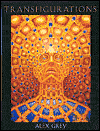
I sit across from my conservative-Pagan friend, the one who only acknowledges art with nature scenes, and prefers that they all involve a lion somewhere. We’re having coffee and one of our friendly, almost loving arguments. I open Transfigurations. I see it right side up, he sees it upside down. A human body, veins and bones exposed, looks back at us. It’s a conversation stopper as well as a conversation starter.
I am fascinated. I tell my friend what I’ve read, about the artist’s dog-phobia and his sleeping on top of a dead body in an effort to understand death and decay. Naturally, the sleeping on feces conversation arises, it’s mentioned in all of its ugliness and is one of those snippets so socially unacceptable that it must be spread. I am moved by the portrayal of his daughter’s conception, and amused by the creation of Grey’s hemp Goddess, thinking the art looks similar to Pagan artist Paul Rucker’s.
My friend looks uncomfortable. At last he says of the art in the seventeen by eleven pages that commands our table space: That’s sick.
I am surprised, and surprised at my own surprise. It’s beautiful I counter.
Beautiful it is, even in the ugly spots. Beautiful it is, because it shows the whole picture of Alex Grey from dumb teen and twenties stunts to “find the art” to genius creation later on in his life. It’s spiritual, it’s moving and it’s something anyone of a mystic Pagan bent should absolutely read. Alex Grey’s creative biography could be the biography of nearly every Pagan, and his life the biography of the Pagan culture in the United States since 1960. As Grey has become more grown-up and spiritual, so have Pagans, and I can only hope as a community we show the balance and beauty in our way of living that Grey has evolved to in his art.
Nowhere in this book, however, does Grey identify as Pagan. No, he is not necessarily a Pagan, and of those who would not confine themselves to definitions, he is one of the few deserving of no title. From degrading to sublime, from life to death Grey’s work and those who write about his work or interview him plumb the mysticism that Grey uses to create and to procreate. As much about the mysteries of the life as it is about the creative process, Transfigurations displays the mind, spirit and soul of the artist in a way that defies traditions of dryly-worded art books or demure coffee table decorations.
Particularly of interest is the way in which Grey makes his artistic process both ritual and visionary. He and his wife make a soul furnace when she is pregnant. He encloses prayers in his world-soul sculpture. Circles, squares and shamanic vision all interplay into a life as artistic process. Hemp and LSD narratives creep in as tools but not as panaceas. Even as a chemical conservative, I am enchanted.
I am treasuring this book, keeping it on my shelf and opening its pages when I need inspiration. Though Grey, the very soul of this work bursts with color and multiple climax. In Transfigurations, Grey erases black and white to replace it with shape, taste and texture.
~ review by Diana Rajchel
by Alex Grey
Inner Traditions International
pp. 168, $49.99
